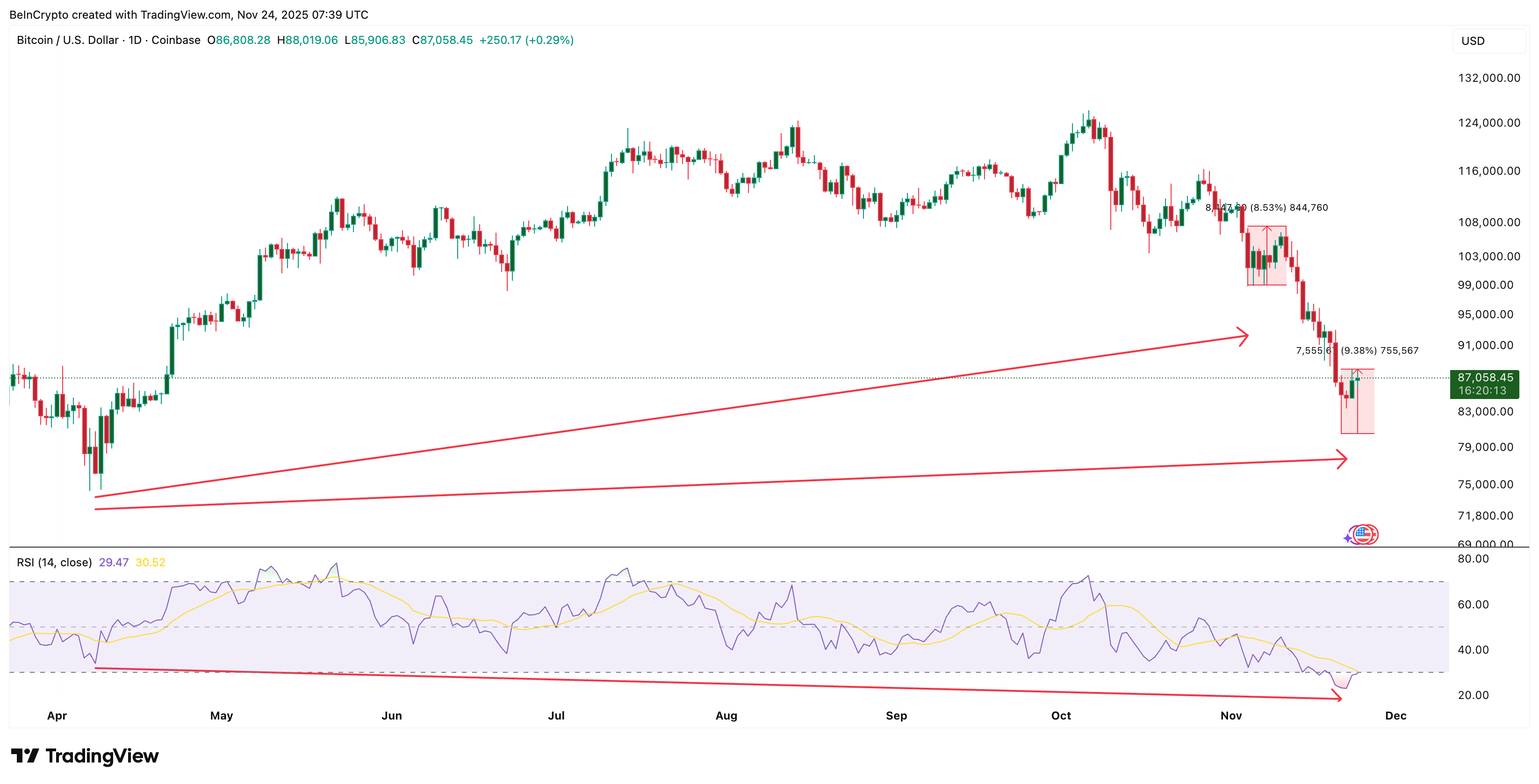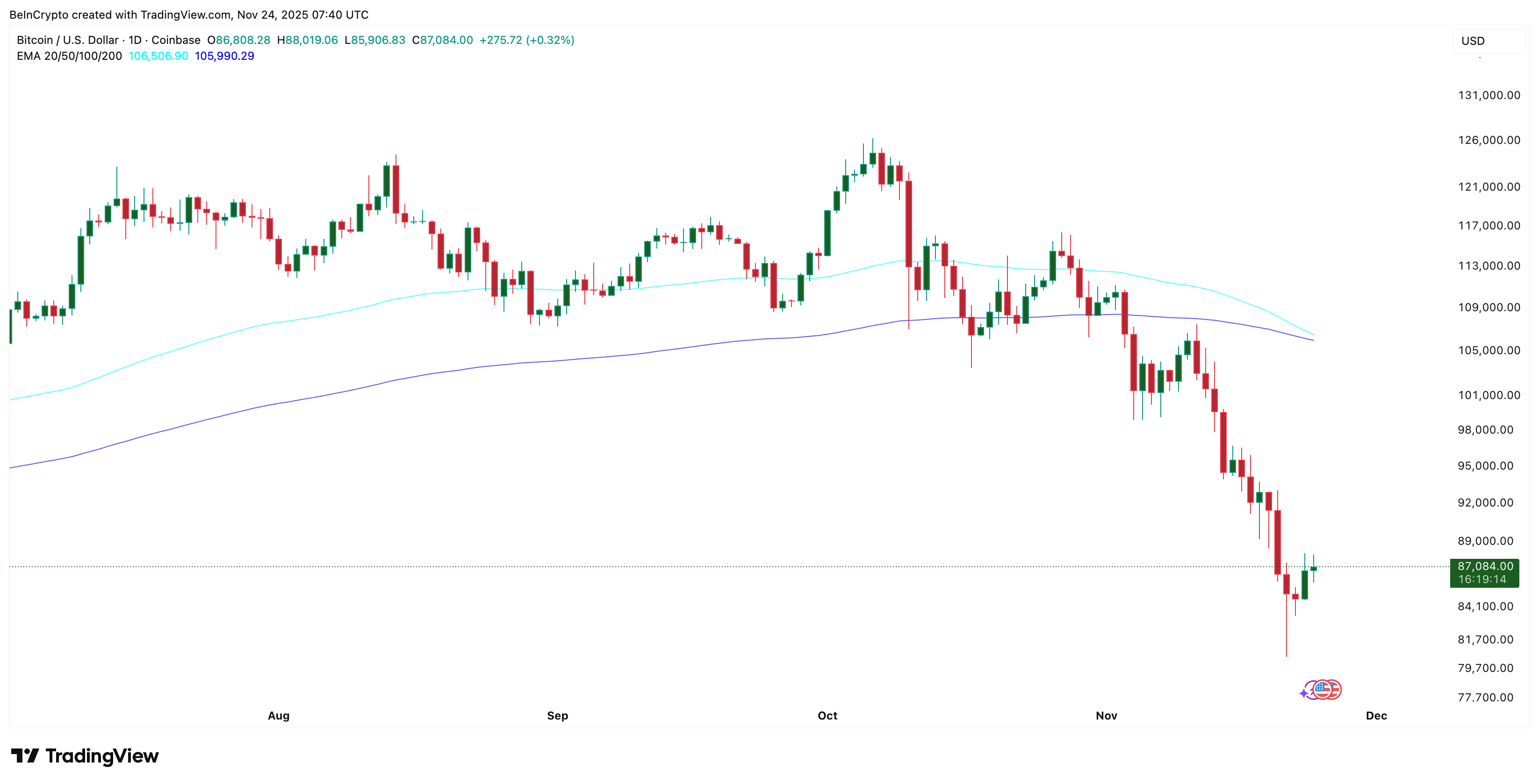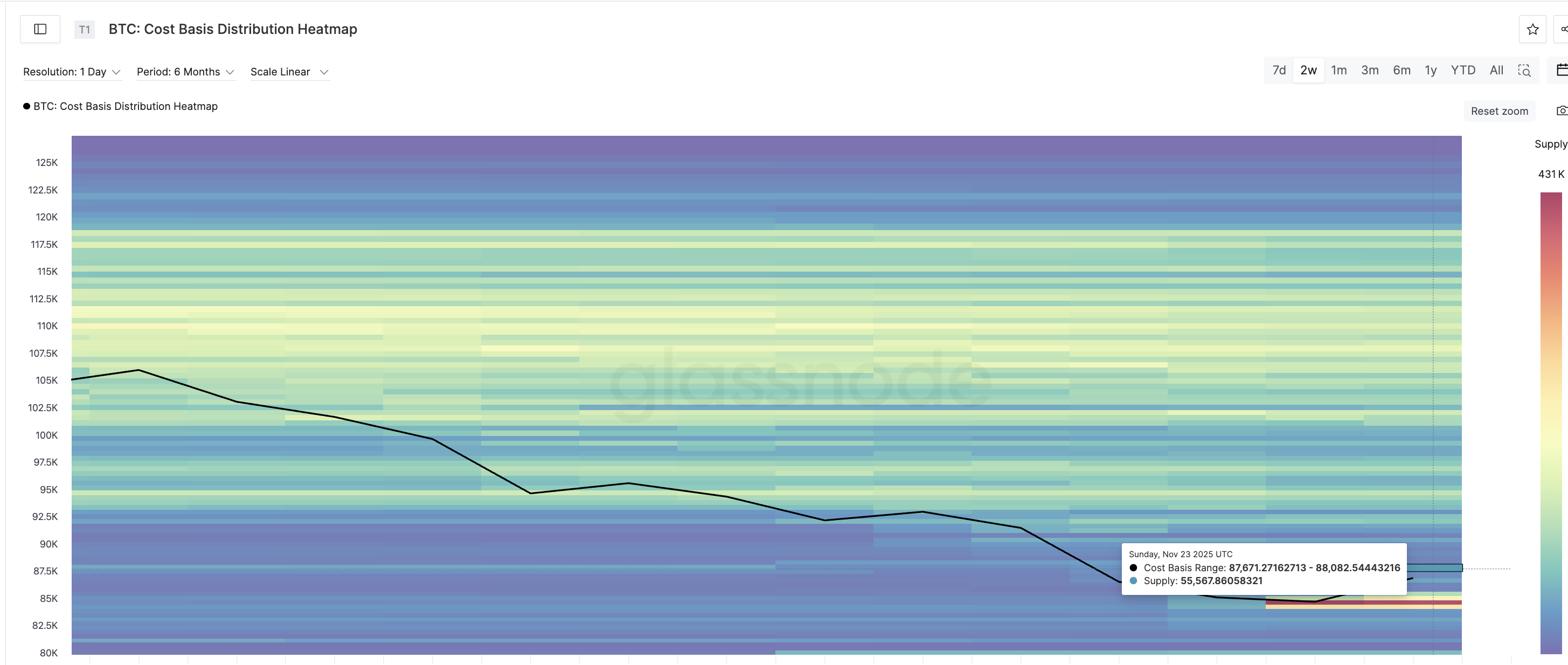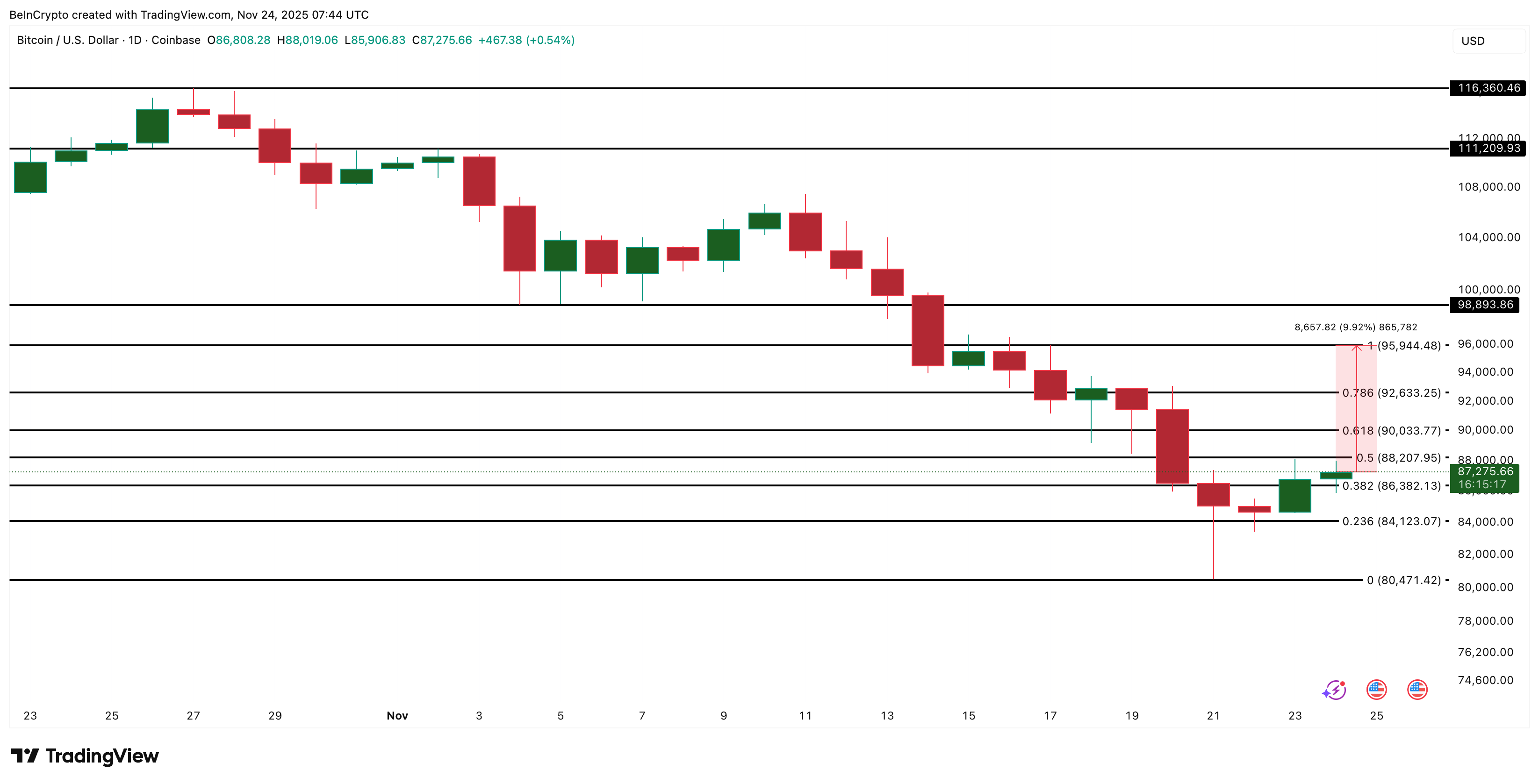Bitcoin’s 9% Bounce Faces a Bearish Wall — Why Moving Past $88,000 Becomes Critical Now?
Bitcoin price is up about 2% today and has already gained almost 9.4% from this week’s lows near $80,400. The move looks solid, and the rebound was expected because of a technical signal that has worked before. But a major risk is building at the same time, near a key level. It could decide whether
Bitcoin price is up about 2% today and has already gained almost 9.4% from this week’s lows near $80,400. The move looks solid, and the rebound was expected because of a technical signal that has worked before.
But a major risk is building at the same time, near a key level. It could decide whether this bounce continues or fails at the next barrier.
Why The Bounce Happened — And What Could Cap It Next
The first sign came from momentum.
Between April 8 and November 22, Bitcoin’s price made a higher low, but the Relative Strength Index (RSI) made a lower low. RSI measures whether momentum is rising or falling by comparing recent gains and losses. This pattern is called hidden bullish divergence. It shows sellers losing strength even while the chart looks weak.
The same setup appeared between April 8 and October 26, and that move created an 8.53% rebound. This time, Bitcoin has already climbed 9.38%, which means the signal played out again.
Want more token insights like this? Sign up for Editor Harsh Notariya’s Daily Crypto Newsletter
 Bitcoin’s Rebound Was Expected:
Bitcoin’s Rebound Was Expected:
But the rebound now runs into a clear problem.
A bearish exponential moving average (EMA) crossover is forming. An EMA reacts faster than a simple moving average because it gives more weight to recent prices. Right now, the 100-day EMA is close to dropping under the 200-day EMA.
Traders treat this as a bearish crossover because it often points to downward pressure lasting for weeks. There is also BTC supply sitting overhead.
 Building Bearish Wall:
Building Bearish Wall:
A heavy cluster now sits above the price between $87,671 and $88,082 — the level where many holders are waiting to sell at breakeven. This cluster holds about 55,567 BTC, currently worth almost $4.83 billion.
 BTC Supply Wall:
BTC Supply Wall:
Most rebounds slow down when they hit these supply zones. So the bounce has momentum behind it, but it also faces its first major test almost immediately.
Bitcoin Price Levels That Decide Whether the Rebound Continues (Or Fails)
The zone around $88,000 now decides everything. Bitcoin must clear $88,200 to turn this bounce into something real. This area lines up with both the heatmap supply band and the 0.5 Fibonacci level from the recent drop.
A clean daily close above this range opens the path toward $92,600.
If buyers stay active, the next extension sits near $95,900 — the same region where the last major BTC price breakdown began.
 Bitcoin Price Analysis:
Bitcoin Price Analysis:
A stronger move only becomes possible if two things happen together:
- BTC Price rises above the $88,000 supply band, and
- The EMA crossover fails to complete.
If the crossover finishes first, it usually caps the rebound and pushes the BTC price lower. On the downside, the $84,449–$84,845 band remains the strongest support, per the cost basis heatmap. That zone holds almost $35.38 billion worth of BTC.
 BTC Supply Zone Acting As Support:
BTC Supply Zone Acting As Support:
On the price chart, the synonymous level sits at $84,100. Bitcoin flipped this cluster into a protective floor after breaking above it.
As long as this zone holds, deeper downside stays limited. If it breaks again, Bitcoin can drop toward the $80,000 region again, invalidating the rebound theory.
Disclaimer: The content of this article solely reflects the author's opinion and does not represent the platform in any capacity. This article is not intended to serve as a reference for making investment decisions.
You may also like
South Korea’s Naver and Dunamu Join Forces to Take On US Stablecoin Leaders Through AI and Blockchain Innovation
- Naver and Dunamu’s $6.8B merger creates a $13.6B fintech entity to boost AI/blockchain integration, targeting global financial infrastructure innovation. - The merged firm plans a Korean won-pegged stablecoin to challenge US dollar-backed tokens, aligning with national sovereignty goals but facing Bank of Korea regulatory barriers. - A $7B investment in AI/blockchain research and talent aims to position South Korea as an Asian tech leader, despite stalled legislation and global stablecoin liquidity gaps.

Bitcoin Updates: Nasdaq Brings Bitcoin Derivatives into the Mainstream by Raising Trading Limits
- Nasdaq ISE proposes expanding IBIT options limits to 1M contracts, aligning with major ETFs to boost Bitcoin derivatives liquidity. - IBIT's 44.6M daily volume and Deribit-surpassing open interest justify the increase, addressing institutional demand for hedging tools. - Experts praise the move for enabling structured products and capital allocation, with SEC seeking public comments until December 17, 2025. - The change signals Bitcoin's integration into mainstream finance, potentially enhancing market e

Reese Witherspoon: Women Should Manage Their Own Finances to Prevent Money Problems
- Reese Witherspoon advocates for women's financial literacy, sharing personal struggles with debt and divorce to highlight systemic economic inequities. - She emphasizes avoiding debt and financial dependence, urging women to prioritize careers as "life insurance" against relationship or career disruptions. - Witherspoon's $900M media company and mother's financial hardships inform her mission to empower women through practical financial education and independence. - Her advocacy aligns with global gender

Bitcoin Updates: Pressure on Bitcoin Miners Signals Potential Upward Price Shift
- Bitcoin surged to $91,950 on Nov. 26, with mining costs near breakeven at $83,873, signaling a potential price inflection point . - Miner margins fell to 4.9% as hash prices dropped below $35/PH/s, extending equipment payback periods beyond 1,200 days. - China's mining share rebounded to 14% amid cheap energy, while institutional holdings like KindlyMD's 5,398 BTC highlight growing adoption. - A declining NVT ratio below its low band suggests imminent consolidation, though macro risks like rising rates c

